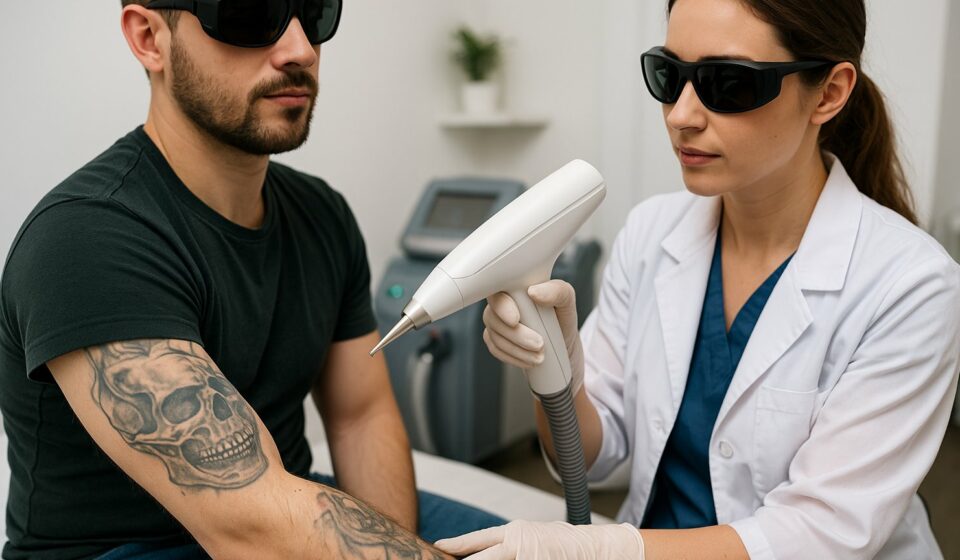Laser tattoo removal uses brief, high energy pulses that seek out pigment, break it into tiny fragments, and let your immune system clear the debris between sessions. That is why fading looks gradual. The ink is not scraped out. It is dismantled, then carried away by normal physiology.
Table Of Content
- Why it works on ink yet spares skin
- 01. What a treatment session actually looks like
- Which wavelengths target which colours
- What happens between sessions
- 02. Sensation, side effects, and aftercare
- Recommended device for professional clinics
- 03. Setting expectations that stick
- Smooth setup and support for clinics
- Key takeaways
Why it works on ink yet spares skin
Laser light is tuned to the ink’s absorption. This principle, called selective photothermolysis, allows the beam to be soaked up by pigment while the surrounding skin absorbs less. Q switched systems fire in ultra short bursts which create a strong photoacoustic effect. Particles crack before heat can spread. If you want the deeper science, see this clinical overview in JAMA Dermatology and a core explainer on selective photothermolysis.
01. What a treatment session actually looks like
- Assessment: colour charting, depth estimate, skin type, medications, and photo records.
- Preparation: cleanse, shave if needed, goggles on, cooling ready. A small patch test if parameters are new.
- First pass: rapid pulses across the design. You see temporary whitening called frosting which fades in minutes.
- Immediate care: cooling, light dressing if required, simple aftercare guidance.

Which wavelengths target which colours
Q switched Nd:YAG is the workhorse for most clinics. Black ink absorbs a wide range of light so it clears most reliably. Reds and oranges respond to green light. Blues and greens can be stubborn and sometimes need additional wavelengths or more sessions. Pale yellows and whites may be resistant, as noted by WebMD.
| Wavelength | Ink colours | Clinical notes |
|---|---|---|
| 1064 nm Nd:YAG | Black, dark blue, dark brown | Deep penetration with low melanin absorption, suitable for a wide range of skin tones. |
| 532 nm KTP | Red, orange, some yellow | Used carefully on lighter skin types due to higher skin absorption. |
| Optional additions | Green, light blue | Some systems add 694 nm or 755 nm to chase specific resistant hues. |
What happens between sessions
After treatment, fractured pigment is picked up by immune cells then moved through lymphatic pathways. Clearance is biological, so it needs time. Spacing sessions six to ten weeks is common, longer for darker skin types or heavily inked areas. Expect the lightest shading to fade first, then outlines and dense fills.
02. Sensation, side effects, and aftercare
- How it feels: sharp snaps that last milliseconds. Strong air cooling and contact gel improve comfort.
- Immediately after: frosting for minutes, then redness and mild swelling for a day or two.
- Risks: with trained operators and cooling, serious effects are uncommon. See NHS guidance on scarring risk and pigment change.
- Aftercare: keep clean and dry, avoid heat and sun, use a simple emollient, do not pick blisters or scabs.

Recommended device for professional clinics
For broad colour coverage and safe energy delivery, a Q switched Nd:YAG that offers both 1064 nm and 532 nm is the practical choice. The Nu Tatouage Plus delivers up to 1500 mJ with dual shot counters and flexible control from footswitch or handpiece. Low running costs keep pricing competitive, while fast pulse delivery shortens chair time without cutting quality.
- Performance: stable beams, reliable energy across sessions, and durable parts that hold calibration.
- Comfort: pair with a dedicated cooling unit to raise tolerance and maintain efficient settings. See Cryo 6.
- Compliance: free training and certification included. Need governance support. Our Laser Protection Advisor service helps with UK requirements.
03. Setting expectations that stick
- How many sessions: small, shallow amateur pieces may clear in fewer visits. Dense, layered, professional designs usually need more.
- Skin type and site: stronger blood flow areas often clear faster. Darker skin types need conservative starts and longer spacing.
- Colour mix: black and red respond well. Pastels may lighten rather than disappear fully.
For pricing ideas and client communication, see How much is tattoo removal and the outcomes guide in Tattoo removal effectiveness.
Smooth setup and support for clinics
Every machine comes with free training and a certificate suitable for insurance. You also get rapid UK support. If a unit cannot be fixed on site, a replacement is dispatched quickly to protect your diary. Want a closer look. Book a demo in Coventry or virtually, or request details for finance and ROI packs.
Key takeaways
- Why it fades: lasers find pigment, fragment it, and your immune system clears it across weeks.
- What influences results: colour, density, skin type, placement, and spacing between sessions.
- The practical kit: Q switched Nd:YAG at 1064 and 532 covers most inks with dependable safety.
Thoughtful protocols and honest timelines make satisfied clients and cleaner portfolios. For a robust clinic setup with training and fast support, start with Nu Tatouage Plus.
Dr Majid Zarandouz
Majid holds a PhD in organic chemistry and has been working with laser systems for decades. His career began in the mid-1990s, when he started researching and developing laser-based technologies for medical and cosmetic applications. Over the years, he has combined scientific expertise with practical engineering to design machines that are effective, durable, and straightforward to use in real clinic settings. As director of the British Institute of Lasers, Majid continues to focus on producing equipment that meets professional standards while remaining accessible to businesses of all sizes.

